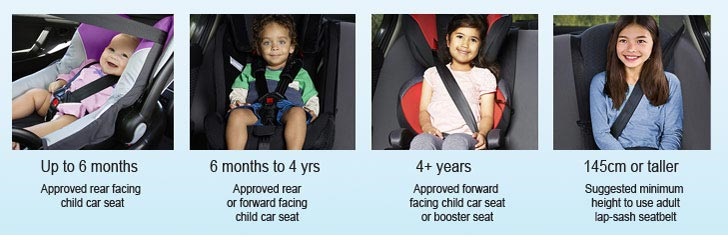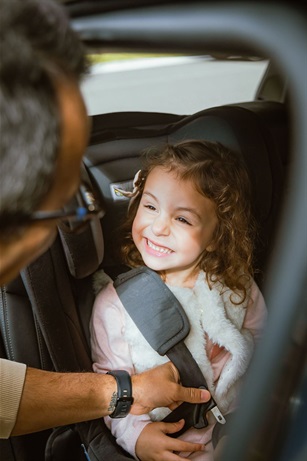The Child Car Seats website lets you quickly find and compare more than 200 types of forward facing, rear facing and booster seats. You can find details of how the seats are tested and rated. The site has information on how to use seats correctly, check if they are still safe and answers to common questions.
All children must be safely fastened in the correct child car seat for their age and size. A child who is properly secured in an approved child car seat is less likely to be injured or killed in a car crash than one who is not.


- Children up to the age of six months must be secured in an approved rearward facing restraint
- Children aged from six months old but under four years old must be secured in either a rear or forward facing approved child restraint with an inbuilt harness
- Children under four years old cannot travel in the front seat of a vehicle with two or more rows
- Children aged from four years old but under seven years old must be secured in a forward facing approved child restraint with an inbuilt harness or an approved booster seat
- Children aged from four years old but under seven years old cannot travel in the front seat of a vehicle with two or more rows, unless all other back seats are occupied by children younger than seven years in an approved child restraint or booster seat
- Children aged from seven years old but under 16 years old who are too small to be restrained by a seatbelt properly adjusted and fastened are strongly recommended to use an approved booster seat
- Children in booster seats must be restrained by a suitable lap and sash type approved seatbelt that is properly adjusted and fastened, or by a suitable approved child safety harness that is properly adjusted and fastened.
If your child is too small for the child restraint specified for their age, they should be kept in their current child restraint until it is safe for them to move to the next level.
If your child is too large for the child restraint specified for their age, they may move to the next level of child restraint.
More information about moving your child to the next type of child car seat and answers to other common questions are available on the Child Car Seats website.
The Child Restraint Evaluation Program provides independent and consistent information to help you choose safe child car seats. The program tests child car seats and rates their level of protection in a crash.
Follow the manufacturer's instructions carefully when fitting child car seats. If the instructions have been lost, contact the manufacturer or search for the instructions online.
To ensure correct and safe installation of your child car seat, contact an Authorised Restraint Fitting Station.